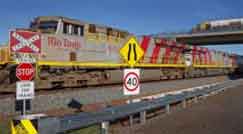Will autonomous or “robot” trains be here soon and when they do will they solve many logistics challenges.
An article last week in the Wall Street Journal says Maybe – and that it is likely we will see adoption of autonomous trainwell in advance of self-driving trucks.
Supply Chain Digest Says...
|
 |
| Another factor is cybersecurity, with fears terrorists could hijack operations of freight trains moving fast and carrying huge tonnages. |
 |
What do you say? |
| Click here to send us your comments |
 |
| Click here to see reader feedback |
|
Of course, trains already carry quite a bit of the US’ total freight tonnage, representing about 33% of the ton-miles - that is, a ton of freight moved for one mile.
What’s more, the US has the largest rail network of any country as measured by miles of track, almost all of it paid for by the rail carriers themselves.
There are several other reasons to believe autonomy may come to the nation’s rail freight movement earlier - perhaps much earlier - than trucks.
For example, trains run on highly controlled tracks with little concerns about other traffic, unlike trucks, which would have to navigate busy streets, lane changes, bad drivers and much more.
In addition, autonomy has proved itself in dozens of cities for subway/light rail transport of people.
A key question, however, is if there would really be that much in the ways gains from making freight train operations autonomous.
Yes, say some, noting autonomous trains “could improve their safety and also significantly increase the amount of freight that can be carried on America’s rail network, by making more efficient use of it,” the Journal article says.
That would occur because the autonomous trains and related developments in train controls are expected to enable trains to be longer and run with less distance between them.
Those efficiency gains would also reduce CO2 emissions from the rail freight sector.
There are just a few early examples of robot train operations. For example, in 2019, Australian mining company Rio Tinto put into service world’s first fully autonomous freight train, moving materials from the Australian outback to ports for shipping. (See Driverless Railroad from Australian Miner Rio Tinto May Show Future of US Rail Freight.)
Others projects are moving forward. For example, a test of a German-Dutch autonomous freight train serving the port of Rotterdam was launched in early October.
An autonomous freight train developed by New York Air Brake was tested in the Colorado desert in 2019. In that trial, AI-based software from the company was used to determine the ideal speed to safely move the train given its location, length, weight and other variables.
(See More Below)
|
CATEGORY SPONSOR: SOFTEON |
|
|
| |
|
|
And the efficiency improvements may be significant. A European Union-based study published in 2020 found that moving to newer systems for managing trains could increase the capacity of existing rail networks by as much 44% - while reducing labor costs substantially.
Of course, nothing is that easy, and there are some important caveats to all this seemingly bullish news.
Most autonomous trains might need to be built on new and dedicated tracks they do not have to share with other, human-controlled trains – and that will involve huge capital outlays and take much time.
These newer systems generally - in the near term at least - do not travel through hazards such as highway crossings, where the vast majority of accidents involving trains and motor vehicle occur.
And just as with autonomous cars and trucks, autonomous locomotives will require kinds of sensing technology to look ahead on the track for unexpected issues and obstacles.
The multiple Us rail carriers, each with their own network of tracks, also complicates things.
 As a result, the transition to autonomy could still “take decades,” Maxim Dulebenets, an assistant professor of civil engineering at Florida A&M University who researches train-related issues, told the Journal. As a result, the transition to autonomy could still “take decades,” Maxim Dulebenets, an assistant professor of civil engineering at Florida A&M University who researches train-related issues, told the Journal.
Another factor is cybersecurity, with fears terrorists could hijack operations of freight trains moving fast and carrying huge tonnages.
But aspects of autonomy are already here. At the end of last year, federal lawn now requires that all US trains be equipped with a Positive Train Control (PTC) system that prevents trains from colliding with other trains, travelling at too high a rate of speed on curves on the tacks , or zooming through railroad switches set incorrectly.
And rail networks have already deployed many signals and sensors, meaning some of the monitoring required to control a train remotely can be built into and alongside the track itself.
On the Rio Tinto system, the Journal reports, utilizes on-board and system-wide sensors. The train itself is equipped with cameras, radar, and a collision detection system, and is also supported by with CCTV cameras at all public rail crossings.
SCDigest’s View: Autonomous trains may get to market before autonomous trucks, but it appears the many complications – including the as yet not mention pushback from rail lab0r unions – means it is likely many years away outside special circumstances such as the Rio Tinto application.
Any thoughts robot trains? Let us know your at the Feedback section below.
|